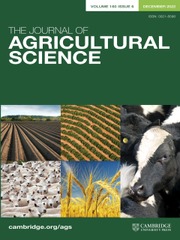Article contents
The dispersion and mechanical analysis of heavy alkaline soils
Published online by Cambridge University Press: 27 March 2009
Extract
1. The form of the dispersion curve obtained by single dispersion treatment below μ/x varies greatly with different soils and with the same soil saturated with different bases. There is no connection between the proportion of very fine material (e.g. below 0·5μ) and other important soil properties. The proportion of the very fine material determined in this way would not, therefore, afford any indication of the “colloid” properties of the soil. If the proportion of fine material were estimated by a decantation method the results might be substantially modified.
2. Under the same conditions of dispersion sodium soil is better dispersed than ammonium. Sodium carbonate should therefore be the best medium for mechanical analysis.
3. No case has been met with where the proportion of clay found is affected to an important degree by the use of hydrogen peroxide.
4. With no soil tried was the number of decantations reduced by the use of acid pre-treatment; those examined gave the same clay content i f sufficient puddlings with sodium carbonate were used with or without acid.
5. No method has been found whereby certain soils can be dispersed i n a single operation as is required in the pipette method. In some cases this is due to gypsum, but there are others in which the cause of the difficulty of dispersion is not yet known.
6. In the cases examined sodium carbonate gives a higher result than ammonia when using the International pipette method.
7. For Sudan soils decantation methods appear essential, hydrogen peroxide unnecessary, acid pre-treatment not essential, and sodium carbonate better than ammonia. We are of opinion that the same holds good for many other soils.
Information
- Type
- Research Article
- Information
- Copyright
- Copyright © Cambridge University Press 1929
References
REFERENCES
- 3
- Cited by

